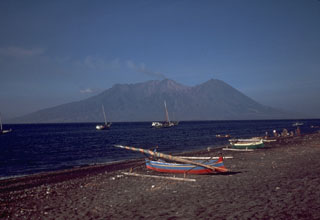Report on Sangeang Api (Indonesia) — December 2009
Bulletin of the Global Volcanism Network, vol. 34, no. 12 (December 2009)
Managing Editor: Richard Wunderman.
Sangeang Api (Indonesia) Explosive eruptions during 1997-1999 were previously unreported
Please cite this report as:
Global Volcanism Program, 2009. Report on Sangeang Api (Indonesia) (Wunderman, R., ed.). Bulletin of the Global Volcanism Network, 34:12. Smithsonian Institution. https://doi.org/10.5479/si.GVP.BGVN200912-264050
Sangeang Api
Indonesia
8.2°S, 119.07°E; summit elev. 1912 m
All times are local (unless otherwise noted)
A recent translation of an older report from the Center of Volcanology and Geological Hazard Mitigation (CVGHM) discussed previously undocumented interval of eruptions at Sangeang Api (figure 3) during 1997-1999. These eruptions were described, along with other known eruptions, in broad terms in their report. They were generally explosive, with lava domes and lava discharges, similar to the eruptions of 1911, 1953, 1954, 1985-1988.
Dali Ahmad confirmed the occurrence of explosive activity during the 1997-1999 period. These took place without causing casualties because, since 1989, all of the island residents had departed to the nearby Sumbawa Island. No additional eruptions were indicated through at least 2009. In recent times the island's summit crater has produced intermittent steam clouds.
Turner and others (2003) used Uranium-series isotopes to provide insights into Sangeang Api magma evolution. The volcano erupts potassic lavas (SiO2 ~47?55%) with a spectrum of xenoliths that record the liquid line of descent. The scientists estimated that the Sangeang Api magma chamber was about 6-10 km3 in volume and underwent cooling rates of ~0.05°C/year.
Reference. Turner, S., Foden, J., George, R., Evans, P., Varne, R., Elburg, M., and Jenner, G., 2003, Rates and processes of potassic magma evolution beneath Sangeang Api volcano, East Sunda Arc, Indonesia: Journal of Petrology, v. 44, no. 3, pp. 491-515.
Geological Summary. Sangeang Api volcano, one of the most active in the Lesser Sunda Islands, forms a small 13-km-wide island off the NE coast of Sumbawa Island. Two large trachybasaltic-to-tranchyandesitic volcanic cones, Doro Api and Doro Mantoi, were constructed in the center and on the eastern rim, respectively, of an older, largely obscured caldera. Flank vents occur on the south side of Doro Mantoi and near the northern coast. Intermittent eruptions have been recorded since 1512, most of them during in the 20th century.
Information Contacts: Dali Ahmad, Center of Volcanology and Geological Hazard Mitigation (CVGHM), Jalan Diponegoro 57, Bandung 40122, Indonesia (URL: http://www.vsi.esdm.go.id/); NASA Earth Observatory (URL: http://earthobservatory.nasa.gov/).


